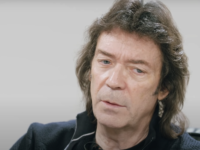Even as he celebrates a 65th birthday today, Steve Hackett is preparing a new solo album. He has, despite a Rock and Roll Hall of Fame career spent in supergroups like Genesis and GTR, never stopped pushing into new areas as a solo artist.
At the same time, Hackett — on more than one occasion — has made deep dives into his own legacy, most recently with the Genesis Revisited II studio album, tour and live sets. But he doesn’t simply engage the past; Steve Hackett reshapes it for a new era, tinkers with it to see if he can suss out new revelations.
If for too long he didn’t get the recognition he so rightly deserved, Steve Hackett has nevertheless emerged more recently as a best-selling concert draw. And Genesis Revisited II was a bonafide hit, reaching No. 25 in his native UK — Hackett’s best-charting effort since a run of six consecutive UK Top 40 solo releases ended with 1983’s Highly Strung.
Up next: Hackett’s first original solo effort since 2011’s Beyond the Shrouded Horizon. Due March 30, 2015 in the UK and April 7 in America via InsideOut, the 10-track Wolflight finds Hackett exploring still more vistas on an album that has been described in pre-release materials as “primal and orchestral.”
Let’s set the stage for Wolflight with this exclusive Something Else! Sitdown, featuring a discussion of tracks from Steve Hackett’s time in Genesis, one of his very best earlier solo outings and the GTR collaboration with Steve Howe. Then check out samples from the new project, with new comments from Hackett, here.
“DANCING WITH THE MOONLIT KNIGHT,” with GENESIS (SELLING ENGLAND BY THE POUND, 1973): A crescendoing, Mellotron-driven epic that moved from accapella reverie to brawny rock bravura, even as Steve Hackett employed both his unique tapping technique (more on that later) as well as an interesting sweep-picking sound. Selling England by the Pound, named after a lyric in this song, was at that point a commercial peak for the group — reaching No. 3 in the UK and going gold in America.
STEVE HACKETT: That tune started off with the influence of a Scottish song, then it moved into something that I think of in a more elegiac way — something nostalgic and wistful, and common to a lot of Genesis tunes. Then it bursts forth, it fights off its shackles, really takes off like a rocket into another section, which seems to borrow from something that sounds more Russian, in a way. It’s European but then, at times, it turns into the jazz that I liked originally — but big band, with the accents. The same idea would get served up several different times, and it will be different each time. I think Genesis was quite fond of doing that with melodies — making a statement of it one way, then a vocal melody and then repeating it. It’s kind of European music, though, isn’t it? It’s not really rock ‘n‘ roll, in the sense that it’s derived from American black music. It’s not really that. But without that influence, we wouldn’t have the electric guitar — so it’s like going to the opposite end of the pond. What I was doing was something that was akin to a violinist’s bow technique, where you are picking across the strings and then back again very quickly. That’s called sweep picking. It was just another way of playing very, very fast. Violinists, J.S. Bach, they all would have been there first, of course. I think it was Bach’s sound that I was trying to play on the guitar. It worked particularly well on that album.
LAST TRAIN TO ISTANBUL, solo (OUT OF THE TUNNEL’S MOUTH, 2009): Steve Hackett’s first prog-rock project in three years was a turbulent, layered outburst of creativity, capped by this exotic album-closing track featuring violinist Ferenc Kovacs. Then emerging from a broken marriage, Hackett traversed a dizzying array of influences and textures as he worked out what must have been a torrent of emotions. Also included are two songs recorded with Yes co-founder Chris Squire (“Fire on the Moon” and “Nomads”), giving a preview of would become a full-scale collaboration on 2012’s Squackett.
STEVE HACKETT: That was the first project that I really did after my divorce. That had been a very dark, difficult period for me to get back on my feet. I did the album in my living room, although it doesn’t sound like that. It was a difficult, traumatic time — and one where I realized that I was clinging to music like a life raft. I had a lot of personal experience to draw from with that. It traversed a number of styles, and I wanted to be able to do that. I always wanted to be able to do what the classical players could do, and the flamenco players. And I wanted to be able to do blues at the same time. That’s what progressive music does, at its best: It doesn’t stick around in any genre long; it’s changing styles. It’s travelogue music, really.
“THE MUSICAL BOX,” with GENESIS (NURSERY CRYME, 1971): Steve Hackett joined Genesis in time to make some influential contributions on Nursery Cryme, Genesis’s first project with the classic five-piece lineup of Tony Banks, Phil Collins, Gabriel, Hackett and Mike Rutherford. The album would reach the Top 40 in England and shoot all the way to No. 4 on the Italian charts on the strength of standout tracks like “The Musical Box.” Originally an instrumental by the newly departed Anthony Phillips, this track eventually emerged as a band collaboration with lyrics based on a Victorian fairy tale courtesy of Gabriel and a eye-popping turn by Hackett. The guitarist fashioned a fresh sound through the use of a new fretboard technique — now simply known as “tapping” — that later reached a broad audience through the fiery soloing of Eddie Van Halen.
STEVE HACKETT: When I joined the band, the song “The Musical Box” was already written. They were performing it live. They said to me: ‘As soon as you join the band, we’ll share all of the writing.’ So, I came up with guitar parts on top of what they had written. I was trying to come up with something suitable. I thought: ‘I wonder if it is possible to use both hands on the fretboard?’ You could play extremely fast on one string. I quickly realized that the sky’s the limit for anyone who wants to use that technique. Eddie has, of course, acknowledged the influence. I came up with the technique, and he gave it a name.
“WHEN THE HEART RULES THE MIND,” with GTR (GTR, 1986): A one-off supergroup that saw Steve Hackett collaborating with fellow guitarist Steve Howe of Yes and producer Geoff Downes (Asia, the Buggles, Yes), GTR’s lone release went gold with a big assist from “When the Heart Rules the Mind” — a song that somehow remains Hackett’s only Top 40 charter in the U.S. His turns here are as concise as they are creatively dense; listen closely, and you’ll hear Hackett quoting both 1980’s “The Steppes” and 1984’s “Duel.” The band, which also featured drummer Jonathan Mover (Marillion, Joe Satriani, Steve Vai), bassist Phil Spalding (Mike Oldfield) and ex-Moby Dick singer Max Bacon (who provided an REO Speedwagon-esque AOR sheen), soon splintered however over creative differences and financial woes.
STEVE HACKETT: We had a hit album in America, and a bankrupt company in England. The price of success was very high, indeed. I think, also, there’s the aspect of novelty value. Being able to sustain a band at that level, it was a case of high finance. At the end of the day, a group is like any company. It has to make sense economically. I mean, I loved “When the Heart Rules the Mind.” I thought it was a great tune. That was the best of the band, straightaway, on that first track. It sounded great on American FM, because that compressed it and made it sound much more powerful. I was very pleased with lots of it. A lot of what GTR did, however, didn’t make it onto records. We did so much in the rehearsal rooms, but you can’t take people there. You just have to say that’s what it is; that’s what it was — a studio album, recorded totally live. What you see is what you get: A completely honest, live album. And I thought I was getting on a bit in the business then! I was only 36. Looking back now, I think it was a very fruitful collaboration.
“FIRTH OF FIFTH,” with GENESIS (SELLING ENGLAND BY THE POUND, 1973): Featuring one of Steve Hackett’s most memorable interludes, this rhythmically complex Tony Banks track finds the guitarist echoing Peter Gabriel’s flute melody and then building upon it — creating a stirring, violin-esque narrative. In the intervening decades, “Firth of Fifth” has become a staple both in Genesis’ and the guitarist’s live repertoire. It has, in fact, appeared on five of his albums — most recently on 2014’s Genesis Revisited: Live at the Royal Albert Hall. For Hackett, who likes to craft brief bursts of imagination within a larger song structure, this remains one of his longest-ever recorded solos.
STEVE HACKETT: I think it can support that, though, because it’s thematic. Basically, it’s the same melody played three times with minimal variation. It’s done like jazz, with the statement of the theme then you go off and improvise, and then return to the theme. On “Firth of Fifth,” when it comes back, it’s a larger arrangement. It’s the tune as written, then ‘let’s take this to the mountains,’ to a certain extent. I was playing it on electric guitar, then it struck me that it had certain similarities with other melodies that I had been playing that I liked. It ended up with aspects of Eric Satie, and aspects of King Crimson. The song had an aspect of blues, an aspect of gospel about it. It had something of English church music — but it also had an aspect of something Oriental or Indian, almost. So, it was a fusion of influences. But at the time, we weren’t using the word fusion and we were using the word progressive. It would eventually be described as progressive, which was a catch-all phase covering an awful lot of bases.
- How Deep Cuts on ‘Music From Big Pink’ Underscore the Band’s Triumph - July 31, 2023
- How ‘Islands’ Signaled the Sad End of the Band’s Five-Man Edition - March 15, 2022
- The Band’s ‘Christmas Must Be Tonight’ Remains an Unjustly Overlooked Holiday Classic - December 25, 2016



